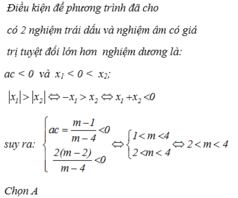Hãy nhập câu hỏi của bạn vào đây, nếu là tài khoản VIP, bạn sẽ được ưu tiên trả lời.

a, Phương trình có hai nghiệm trái dấu khi \(2\left(2m^2-3m-5\right)< 0\)
\(\Leftrightarrow\left(2m-5\right)\left(m+1\right)< 0\)
\(\Leftrightarrow-1< m< \dfrac{5}{2}\)
b, TH1: \(m^2-3m+2=0\Leftrightarrow\left[{}\begin{matrix}m=1\\m=2\end{matrix}\right.\)
Phương trình đã cho có nghiệm duy nhất
TH2: \(m^2-3m+2\ne0\Leftrightarrow\left\{{}\begin{matrix}m\ne1\\m\ne2\end{matrix}\right.\)
Phương trình có hai nghiệm trái dấu khi \(-5\left(m^2-3m+2\right)< 0\)
\(\Leftrightarrow m^2-3m+2>0\)
\(\Leftrightarrow\left[{}\begin{matrix}m>2\\m< 1\end{matrix}\right.\)
Vậy \(m>2\) hoặc \(m< 1\)

(m-1)x2-2mx+m-2=0(m\(\ne1\) )
\(\Delta\)'=\(m^2-\left(m-2\right)\left(m-1\right)\)
=\(m^2-m^2+m+2m-2\)
=3m-2
Để pt có nghiệm 2 ngiệm trái dấu thì \(\Delta\) ' =3m-2>0\(\Leftrightarrow m>\dfrac{2}{3}\)
Áp dụng hệ thức Viet, ta có
\(\left\{{}\begin{matrix}x_1+x_2=\dfrac{2m}{m-1}\\x_1.x_2=\dfrac{m-2}{m-1}\end{matrix}\right.\)
Để PT có 2 nghiệm trái dấu thì x1x2<0\(\Leftrightarrow\dfrac{m-2}{m-1}< 0\)
\(\Rightarrow\left[{}\begin{matrix}\left\{{}\begin{matrix}m-2< 0\\m-1>0\end{matrix}\right.\\\left\{{}\begin{matrix}m-2>0\\m-1< 0\end{matrix}\right.\end{matrix}\right.\Leftrightarrow\)\(\left[{}\begin{matrix}\left\{{}\begin{matrix}m< 2\\m>1\end{matrix}\right.\\\left\{{}\begin{matrix}m>2\\m< 1\end{matrix}\right.\end{matrix}\right.\)\(\Rightarrow1< m< 2\)
Vậy 1<m<2 thì pt có 2 nghiệm trái dấu
câu b
.Với m=1\(\Rightarrow-2x-1=0\Leftrightarrow x=\dfrac{-1}{2}\left(l\right)\)
.Với \(m\ne1\)
\(\Rightarrow\Delta\)'=3m-2\(\ge0\Leftrightarrow m\ge\dfrac{2}{3}\)

\(x^3-x^2+2mx-2m=0\)
\(\Leftrightarrow x^2\left(x-1\right)+2m\left(x-1\right)=0\)
\(\Leftrightarrow\left(x-1\right)\left(x^2+2m\right)=0\)
\(\Leftrightarrow\left[{}\begin{matrix}x=1\\x^2=-2m\end{matrix}\right.\)
Để pt có 3 nghiệm \(\Rightarrow-2m>0\Rightarrow m< 0\)
a. Do vai trò 3 nghiệm như nhau, ko mất tính tổng quát giả sử \(x_1=1\) và \(x_2;x_3\) là nghiệm của \(x^2+2m=0\)
Để pt có 3 nghiệm pb \(\Rightarrow\left\{{}\begin{matrix}-2m>0\\-2m\ne1\end{matrix}\right.\) \(\Rightarrow\left\{{}\begin{matrix}m< 0\\m\ne-\dfrac{1}{2}\end{matrix}\right.\)
Khi đó: \(x_2+x_3=0\Rightarrow x_1+x_2+x_3=1\ne10\) với mọi m
\(\Rightarrow\) Không tồn tại m thỏa mãn yêu cầu
b.
Giả sử pt có 3 nghiệm, khi đó \(\left[{}\begin{matrix}x_2=-\sqrt{-2m}< 0< 1\\x_3=\sqrt{-2m}\end{matrix}\right.\)
\(\Rightarrow\) Luôn có 1 nghiệm của pt âm \(\Rightarrow\) không tồn tại m thỏa mãn
Em coi lại đề bài

\(\Leftrightarrow\left\{{}\begin{matrix}\Delta=4m^2-4\left(m+2\right)\left(m-1\right)\ge0\\x_1x_2=\dfrac{m+2}{m-1}< 0\end{matrix}\right.\\ \Leftrightarrow\left\{{}\begin{matrix}-4m+8\ge0\\-2< m< 1\end{matrix}\right.\Leftrightarrow\left\{{}\begin{matrix}m\ge2\\-2< m< 1\end{matrix}\right.\Leftrightarrow m\in\varnothing\)

Bài 2:
Để phương trình có hai nghiệm trái dấu thì (m-2)(m+2)<0
hay -2<m<2

a, Phương trình có hai nghiệm khi
\(\Delta'=m^2-2\left(m^2-2\right)=-m^2+4\ge0\Leftrightarrow-2\le m\le2\)
b, Theo định lí Viet \(\left\{{}\begin{matrix}x_1+x_2=-m\\x_1x_2=\dfrac{m^2-2}{2}\end{matrix}\right.\)
\(A=\left|2x_1x_2+x_1+x_2-4\right|\)
\(=\left|m^2-2-m-4\right|\)
\(=\left|\left(m-\dfrac{1}{2}\right)^2-\dfrac{25}{4}\right|\)
\(=\left|-\left(m-\dfrac{1}{2}\right)^2+\dfrac{25}{4}\right|\le\dfrac{25}{4}\)
\(maxA=\dfrac{25}{4}\Leftrightarrow m=\dfrac{1}{2}\)
